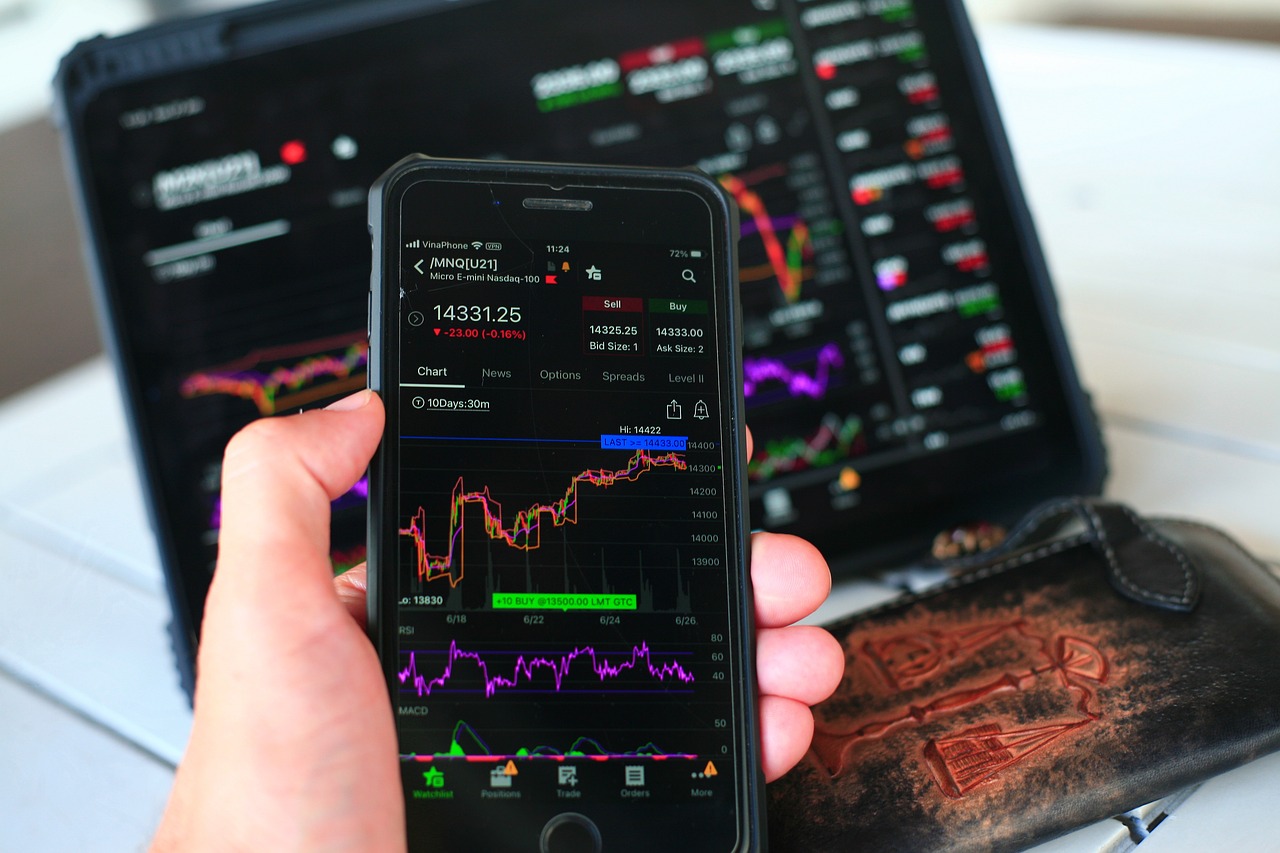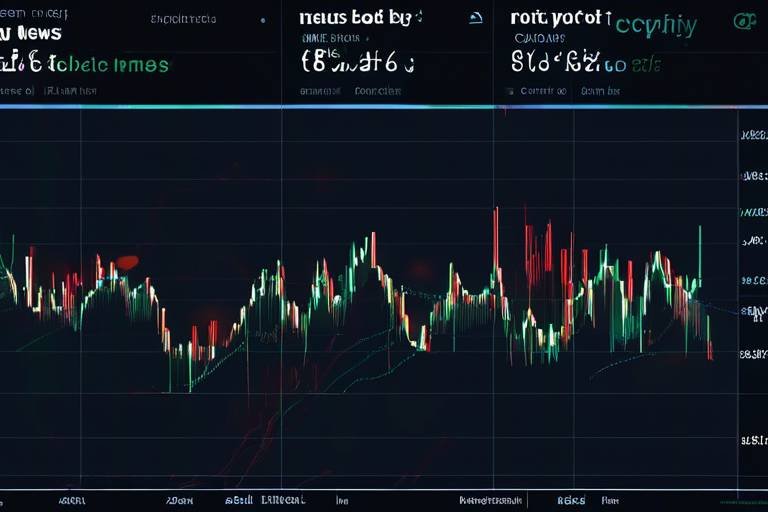Understanding Market Trends - What Drives Investor Behavior
In the ever-evolving landscape of finance, understanding market trends is not just an option; it’s a necessity for anyone looking to invest wisely. But what exactly drives these trends? Well, it’s a complex interplay of various factors, ranging from economic indicators to psychological influences. Imagine navigating a ship through turbulent waters; knowing which currents to follow can mean the difference between a bumpy ride and smooth sailing. In this article, we will delve into the intricacies of market dynamics, unraveling the threads that shape investor behavior and ultimately influence investment decisions.
Economic indicators are like the pulse of the economy, providing crucial insights into its overall health. Key indicators such as Gross Domestic Product (GDP), unemployment rates, and inflation serve as essential tools for investors. They help paint a picture of economic stability and growth potential. For instance, a rising GDP typically signals a healthy economy, which can lead to increased investor confidence. Conversely, high unemployment rates might trigger caution among investors, leading to a more conservative approach. By keeping an eye on these indicators, investors can make informed decisions that align with broader economic trends.
Now, let’s shift gears and talk about the human element—investor psychology. It’s fascinating how emotions can drive market behavior. Think about it: fear and greed are powerful motivators that can lead to irrational decision-making. When the market is booming, the feeling of euphoria can lead investors to make hasty choices, often resulting in missed opportunities or losses. Understanding this psychological landscape is crucial for navigating the often-turbulent waters of investing.
One interesting phenomenon in investor psychology is herd behavior. This occurs when investors collectively follow the crowd, often leading to market bubbles or crashes. It’s like a flock of birds; when one takes flight, the rest follow without questioning where they are heading. Recognizing this behavior can empower investors to make more rational choices. Instead of succumbing to the collective emotions, they can rely on their analysis and instincts.
Another psychological trap that investors often fall into is the Fear of Missing Out (FOMO). During bullish markets, the fear of missing a lucrative opportunity can drive impulsive decisions. It’s akin to being at a party where everyone is dancing, and you feel pressured to join in, even if you’re not in the mood. By understanding FOMO, investors can maintain a disciplined approach to investing, ensuring their decisions are based on sound analysis rather than fleeting emotions.
Loss aversion is another critical concept in investor psychology. It refers to the tendency of investors to prefer avoiding losses rather than acquiring equivalent gains. This bias can lead to overly cautious behavior, causing investors to miss out on potential opportunities. Imagine holding onto a sinking ship out of fear of losing your belongings; sometimes, letting go is the smarter choice. By recognizing this bias, investors can adjust their strategies to embrace calculated risks.
Market sentiment is the overall attitude of investors toward a particular security or financial market. It’s like the mood of a crowd at a concert—one moment everyone is excited, and the next, they’re anxious. Analyzing market sentiment can provide valuable insights into potential market movements and trends. By gauging the mood, investors can make more informed decisions that align with prevailing sentiments.
Global events can dramatically influence market trends. From geopolitical tensions to natural disasters and pandemics, the external environment plays a significant role in shaping investor behavior. Understanding these factors is essential for predicting market responses and adjusting investment strategies accordingly. For instance, a sudden political upheaval can lead to market fluctuations, making it vital for investors to stay informed about global developments.
Political stability is crucial for investor confidence. Changes in government policies or political unrest can send shockwaves through the market. It’s like trying to build a sandcastle during a storm; the foundation must be solid. Investors need to keep an eye on political developments to navigate these unpredictable waters effectively.
Technological advancements can disrupt markets and create new trends. Investors must keep an eye on emerging technologies that can reshape industries and influence their investment strategies. Think of it as being on the cutting edge of a wave; those who catch it early can ride it to success. By staying informed about technological innovations, investors can position themselves advantageously in the market.
Understanding the difference between long-term and short-term market trends is essential for investors. This knowledge aids in aligning investment strategies with individual financial goals and risk tolerance. Long-term trends are like the steady flow of a river, while short-term trends resemble ripples on the surface. By recognizing these distinctions, investors can make more informed decisions that align with their financial objectives.
- What are the key economic indicators to watch?
Key indicators include GDP, unemployment rates, inflation, and consumer confidence. These metrics provide insights into the overall health of the economy. - How does investor psychology affect market trends?
Investor psychology, influenced by emotions like fear and greed, can lead to irrational decision-making, impacting market stability. - What is herd behavior in investing?
Herd behavior occurs when investors collectively follow the crowd, often leading to market bubbles or crashes. - How can global events impact investment decisions?
Global events such as geopolitical tensions or natural disasters can dramatically influence market trends and investor behavior.

The Role of Economic Indicators
Economic indicators are like the compass guiding investors through the vast ocean of financial markets. They provide essential information about the health of an economy, which in turn influences market trends. Key indicators such as Gross Domestic Product (GDP), unemployment rates, and inflation are vital for understanding where the market might head next. For instance, a rising GDP typically signals a growing economy, which can lead to increased investor confidence and higher stock prices. Conversely, a spike in unemployment can trigger fears of economic downturn, leading to market sell-offs.
Let's take a closer look at some of these indicators:
- Gross Domestic Product (GDP): This measures the total value of all goods and services produced in a country. A growing GDP indicates a healthy economy, while a shrinking GDP can signal trouble.
- Unemployment Rates: High unemployment can lead to reduced consumer spending, which negatively impacts businesses and their stock prices. Investors closely monitor these rates to gauge economic stability.
- Inflation: This reflects the rate at which the general level of prices for goods and services rises, eroding purchasing power. Moderate inflation is often seen as a sign of a growing economy, but high inflation can lead to tighter monetary policy, which can cool off market enthusiasm.
Understanding these indicators helps investors not only to make informed decisions but also to anticipate market movements. For example, if inflation rates begin to climb significantly, investors might brace themselves for potential interest rate hikes from central banks, which could lead to a downturn in stock prices. On the flip side, if unemployment rates drop and GDP grows steadily, it could signal a bull market, enticing more investors to enter the fray.
Moreover, it's not just about the numbers themselves. The context in which these indicators are released plays a crucial role. For instance, if GDP growth is accompanied by rising inflation, it may lead investors to interpret the data differently than if growth were occurring alongside stable prices. Hence, savvy investors often look at a combination of indicators rather than relying on a single metric. This multifaceted approach allows them to paint a clearer picture of the economic landscape.
In conclusion, economic indicators serve as essential tools for investors. They provide a framework for understanding market dynamics and can significantly influence investment decisions. By keeping a close eye on these indicators, investors can better navigate the complexities of the market and align their strategies with the prevailing economic conditions.
- What is the most important economic indicator? While there isn't a single most important indicator, GDP, unemployment rates, and inflation are often considered critical for assessing economic health.
- How do economic indicators affect stock prices? Positive indicators can boost investor confidence, leading to higher stock prices, while negative indicators can trigger sell-offs.
- Can economic indicators predict market trends? They can provide insights and guidance, but they are not foolproof predictors of market movements.

Investor Psychology
When it comes to investing, the mind can be a tricky place. plays a pivotal role in shaping market behavior, often leading individuals to make decisions that are not entirely rational. Have you ever found yourself caught up in the excitement of a stock's rising price, only to realize later that your decision was primarily driven by emotion rather than analysis? You're not alone! Emotions like fear and greed can significantly sway investor behavior, creating a whirlwind of volatility that can leave even seasoned investors feeling dizzy.
Understanding these psychological influences is crucial for anyone looking to navigate the often-turbulent waters of the financial markets. One of the most interesting phenomena in investor psychology is herd behavior. This term refers to the tendency of investors to mimic the actions of a larger group. Picture a flock of sheep following one another without questioning where they’re headed. This behavior can lead to market bubbles or crashes, as investors flock to what seems popular without conducting their own due diligence. Recognizing this tendency can empower investors to make more informed choices, rather than simply following the crowd.
Another significant psychological factor is the Fear of Missing Out (FOMO). In a world where social media amplifies the success stories of others, it’s easy to feel like you’re missing out on the next big thing. FOMO can drive impulsive decisions, especially during bullish markets when everyone seems to be making money. It’s essential for investors to maintain a disciplined approach, reminding themselves that investing is a marathon, not a sprint. Just because everyone else is jumping on a bandwagon doesn’t mean it’s the right choice for you.
Then there’s the concept of loss aversion. This psychological bias suggests that the pain of losing money is greater than the pleasure of gaining an equivalent amount. For example, if you lose $100, the emotional impact can feel much heavier than the joy of earning $100. This bias can lead to overly cautious behavior, causing investors to hold onto losing positions for too long or avoiding potentially profitable opportunities. Understanding this bias can help investors strike a balance between caution and opportunity, allowing them to make smarter decisions.
In conclusion, the realm of investor psychology is complex and multifaceted. By being aware of how emotions, herd behavior, FOMO, and loss aversion can influence their decisions, investors can adopt a more rational approach to investing. This awareness not only helps in making informed choices but also aids in navigating the unpredictable landscape of the financial markets with greater confidence.
- What is investor psychology? Investor psychology refers to the emotional and cognitive factors that influence investors' decisions and behavior in the financial markets.
- How does fear affect investing? Fear can lead to panic selling and irrational decision-making, causing investors to act against their best interests.
- What is herd behavior? Herd behavior is when investors follow the actions of a larger group, often leading to market bubbles or crashes.
- What is FOMO in investing? FOMO, or Fear of Missing Out, drives investors to make impulsive decisions out of anxiety that they will miss out on profitable opportunities.
- How can I overcome loss aversion? Understanding that losses are a part of investing and focusing on long-term goals can help mitigate the effects of loss aversion.

Herd Behavior
Have you ever noticed how people often follow the crowd, even when it seems irrational? This phenomenon, known as , is prevalent in the investment world and can lead to significant market fluctuations. When investors collectively decide to buy or sell based on the actions of others, it creates a ripple effect that can inflate prices or trigger crashes. Imagine a flock of birds suddenly changing direction; it’s not just one bird making a decision, but the entire flock reacting to a perceived threat or opportunity.
Herd behavior can be both a blessing and a curse. On one hand, it can lead to rapid price increases during bullish markets, where everyone seems to be making money. On the other hand, it can also result in devastating losses when the herd turns and panic sets in. For instance, during the dot-com bubble of the late 1990s, many investors jumped on the tech bandwagon without fully understanding the underlying companies. When the bubble burst, those same investors faced massive losses, often because they were simply following the crowd.
Understanding herd behavior requires a keen awareness of market psychology. Here are some key factors that contribute to this phenomenon:
- Emotional Influence: Fear and greed are powerful motivators. When investors see others making profits, they often feel compelled to join in, fearing they might miss out on potential gains.
- Social Proof: Humans are inherently social creatures. We tend to look to others for guidance, especially in uncertain situations. If everyone is buying, it can create a false sense of security.
- Information Asymmetry: Not all investors have access to the same information. When a few influential players make a move, it can trigger a wave of followers who act without fully understanding the situation.
Recognizing herd behavior is crucial for investors who wish to maintain a rational approach to their investment strategies. Instead of jumping on the bandwagon, consider taking a step back and analyzing the fundamentals of the investment. Ask yourself, “Is this decision based on solid research or just a reaction to what others are doing?” By cultivating a disciplined mindset, you can navigate the market more effectively, avoiding the pitfalls of emotional trading.
In conclusion, while herd behavior is a natural part of investing, it’s essential to remain vigilant and not let the crowd dictate your decisions. By understanding the underlying psychological factors and maintaining a level of skepticism, you can make more informed investment choices that align with your financial goals.
Q: What is herd behavior in investing?
A: Herd behavior refers to the tendency of investors to follow the actions of a larger group, often leading to irrational decision-making and market volatility.
Q: How can I avoid falling into herd behavior?
A: To avoid herd behavior, focus on conducting thorough research, develop a clear investment strategy, and maintain discipline even when others are acting impulsively.
Q: What are the consequences of herd behavior?
A: The consequences can include inflated asset prices, market bubbles, and significant losses when the crowd suddenly shifts direction.

Fear of Missing Out (FOMO)
The Fear of Missing Out, or FOMO, is a powerful psychological phenomenon that grips many investors, particularly during bullish market conditions. Imagine standing at the edge of a party where everyone is having a great time, and you’re left outside wondering what you’re missing. That’s FOMO in the investment world! It compels individuals to jump into investments they might not fully understand, simply because they see others profiting. This impulsive behavior can lead to significant financial mistakes.
FOMO often manifests itself during market surges, where the excitement and potential for quick profits can overshadow rational decision-making. Investors may start to chase stocks that are rapidly increasing in value, driven by the fear that if they don’t act now, they’ll miss out on substantial gains. However, this rush can lead to buying at inflated prices, resulting in losses when the market corrects itself. It’s like trying to catch a train that’s already left the station—you might end up stranded if you’re not careful!
To combat FOMO, it’s essential for investors to develop a solid investment strategy that aligns with their long-term goals. Here are some tips to help manage this fear:
- Set Clear Goals: Define what you want to achieve with your investments. This clarity can help you resist impulsive decisions driven by FOMO.
- Do Your Research: Before investing, take the time to understand the market and the specific assets you’re considering. Knowledge is a powerful antidote to fear.
- Practice Patience: Remember that investing is a marathon, not a sprint. Staying patient can help you avoid the pitfalls of FOMO.
In conclusion, while FOMO can be a strong motivator, it’s crucial for investors to recognize its influence and take steps to mitigate its effects. By maintaining a disciplined approach and focusing on long-term objectives, you can navigate the market more effectively and avoid the traps that FOMO lays out. After all, successful investing isn’t about chasing trends; it’s about making informed decisions that align with your financial goals.
Q1: What is FOMO in investing?
A1: FOMO, or Fear of Missing Out, refers to the anxiety that investors feel when they see others profiting from investments, leading them to make impulsive decisions without proper research.
Q2: How can I avoid FOMO?
A2: To avoid FOMO, establish clear investment goals, conduct thorough research, and cultivate patience in your investment strategy.
Q3: Is FOMO always negative?
A3: While FOMO can lead to impulsive and poor investment decisions, being aware of market trends can also motivate investors to take action when necessary. The key is to balance awareness with caution.

Loss Aversion
Loss aversion is a fascinating psychological phenomenon that plays a significant role in how investors make decisions. It refers to the tendency of individuals to prefer avoiding losses rather than acquiring equivalent gains. In simpler terms, the pain of losing $100 feels much stronger than the pleasure of gaining $100. This bias can profoundly influence market behavior, leading many investors to make overly cautious choices that could prevent them from seizing lucrative opportunities.
Imagine you're at a carnival, and you see a game where you can win a stuffed animal. The cost to play is $5, but there's a 50% chance you'll lose. Now, think about how you feel when you lose that $5. It stings, right? Now, consider the joy of winning that stuffed animal. While it's exciting, the thrill doesn't quite match the disappointment of losing your money. This analogy illustrates how loss aversion can skew our decision-making. In the world of investing, this bias may lead investors to hold onto losing stocks for too long, hoping to break even, rather than cutting their losses and reallocating their funds to more promising opportunities.
Moreover, loss aversion can also create a ripple effect in the market. When investors collectively react to losses with fear, they may sell off their assets en masse, leading to a market downturn. This behavior can exacerbate volatility, as panic selling can drive prices down further, creating a vicious cycle. Understanding this psychological trap is crucial for investors. They need to recognize their emotional responses and strive to maintain a disciplined approach to investing.
To combat loss aversion, investors can employ several strategies:
- Set Clear Goals: Establishing clear, achievable investment goals can help keep emotions in check.
- Diversify Investments: A well-diversified portfolio can mitigate the impact of individual losses.
- Focus on Long-Term Gains: Shifting the focus from short-term fluctuations to long-term objectives can help reduce the emotional impact of losses.
In conclusion, loss aversion is a powerful force that can shape investor behavior and market trends. By understanding this bias and implementing strategies to manage it, investors can make more rational decisions and improve their chances of achieving their financial goals.
What is loss aversion?
Loss aversion is the psychological phenomenon where individuals prefer to avoid losses rather than acquire equivalent gains, leading to overly cautious investment behavior.
How does loss aversion affect investment decisions?
It can cause investors to hold onto losing investments for too long, hoping to break even, instead of cutting losses and reallocating funds to better opportunities.
What strategies can help mitigate loss aversion?
Investors can set clear goals, diversify their portfolios, and focus on long-term gains to manage the emotional impact of losses.

Market Sentiment
Market sentiment is a powerful force that can sway the direction of financial markets, often more than fundamental factors like earnings reports or economic indicators. It represents the overall attitude of investors toward a particular security or the market as a whole. Think of it as the mood of the market—just like how a crowd can sway one way or another based on the energy in the room, investors can be influenced by collective feelings about market conditions.
Understanding market sentiment is essential for investors because it provides insights into potential price movements. For instance, when sentiment is bullish, it often indicates that investors are optimistic about future price increases, leading to more buying activity. Conversely, bearish sentiment reflects pessimism and can trigger selling, creating downward pressure on prices. This emotional landscape is driven by various factors, including news events, economic data releases, and even social media buzz.
To gauge market sentiment, investors often look at a variety of indicators, which can be categorized into two main types: quantitative and qualitative. Quantitative measures might include:
- Market volume
- Price trends
- Volatility indexes, like the VIX
On the other hand, qualitative measures could involve analyzing investor surveys or sentiment indicators, such as the Consumer Confidence Index (CCI) or the AAII Sentiment Survey. These tools help investors assess whether the market is leaning toward optimism or pessimism.
Moreover, social media platforms have become an integral part of understanding market sentiment. Investors now turn to Twitter, Reddit, and other platforms to gauge public opinion and sentiment. The rise of meme stocks is a perfect example of how social media can create a frenzy, driving prices up or down based on sentiment rather than fundamentals. This phenomenon highlights the importance of being aware of not just the numbers, but also the narratives that shape investor behavior.
In summary, market sentiment is a crucial element that can significantly impact investment decisions. By staying attuned to the mood of the market, investors can better navigate the complexities of buying and selling, ultimately leading to more informed and strategic choices.
What is market sentiment?
Market sentiment refers to the overall attitude of investors towards a particular security or financial market, which can be either optimistic (bullish) or pessimistic (bearish).
How can I measure market sentiment?
Market sentiment can be measured using quantitative indicators like market volume and volatility indexes, as well as qualitative surveys such as the Consumer Confidence Index.
Why is market sentiment important for investors?
Understanding market sentiment helps investors anticipate potential price movements and make more informed decisions based on the collective emotions of the market.
How does social media influence market sentiment?
Social media platforms allow investors to share opinions and insights, which can rapidly influence market sentiment, sometimes leading to significant price swings based on collective feelings rather than fundamentals.

Global Events and Their Impact
Global events have a profound impact on market trends, influencing investor behavior and shaping financial landscapes in ways that can be both predictable and surprising. Think of the markets as a vast ocean, where every ripple and wave represents a shift in investor sentiment, often triggered by external factors. For instance, geopolitical tensions can create uncertainty, prompting investors to pull back and reassess their strategies. Similarly, natural disasters can disrupt supply chains and affect stock prices, while pandemics can lead to widespread economic downturns.
Understanding these global events is essential for investors looking to navigate the turbulent waters of the financial markets. To illustrate this, consider the following key global events and their potential impacts:
| Event Type | Potential Impact on Markets |
|---|---|
| Geopolitical Tensions | Increased volatility, potential for market sell-offs, and shifts in sector performance (e.g., energy stocks may rise during conflicts). |
| Natural Disasters | Supply chain disruptions, increased costs for companies, and potential for insurance claims leading to market declines. |
| Pandemics | Economic slowdowns, shifts in consumer behavior, and increased volatility in healthcare and technology sectors. |
| Economic Policies | Changes in interest rates, fiscal stimulus, or trade agreements can lead to immediate market reactions and long-term shifts. |
Moreover, investors must remain vigilant about political stability in various regions. Political unrest or changes in government can lead to sudden market fluctuations, as seen in various countries experiencing upheaval. The key takeaway here is that staying informed about global events can provide investors with the foresight needed to adjust their strategies proactively. Just like a sailor who checks the weather before setting sail, investors should keep an eye on the global horizon.
Additionally, technological advancements can also be considered a global event that disrupts traditional market dynamics. The rapid evolution of technology creates new opportunities and challenges, prompting investors to rethink their strategies. For example, the rise of electric vehicles has not only transformed the automotive industry but has also affected oil markets and renewable energy sectors. Investors who grasp these changes early can position themselves favorably, capitalizing on trends before they become mainstream.
In conclusion, global events act as catalysts that can either propel markets forward or cause them to retreat. For investors, understanding these dynamics is not just beneficial; it's essential for making informed decisions. By keeping a pulse on global happenings, investors can better navigate the complexities of market trends and align their strategies with the ever-changing economic landscape.
- How do geopolitical tensions affect stock prices? Geopolitical tensions often lead to uncertainty, which can cause investors to sell off stocks, leading to decreased prices.
- What role do natural disasters play in market fluctuations? Natural disasters can disrupt supply chains and lead to increased costs for companies, which may negatively impact their stock prices.
- How can I stay informed about global events? Investors can stay informed by following reliable news sources, subscribing to financial newsletters, and utilizing market analysis tools.
- Are technological advancements always beneficial for investors? While technological advancements can create new opportunities, they can also disrupt existing markets, so it's essential to evaluate their potential impact carefully.

Political Stability
Political stability is like the bedrock of a flourishing economy; without it, everything can crumble. When investors look at a country's investment climate, they often check for signs of political stability. Think of it as a ship sailing through calm waters versus turbulent seas. A stable political environment fosters investor confidence, while instability can create waves of uncertainty that send investors running for the hills.
Changes in government policies, unexpected elections, or political unrest can trigger market fluctuations that leave investors feeling uneasy. For instance, a sudden shift in trade policies can alter the landscape for businesses and investors alike. Imagine waking up one day to find that tariffs have skyrocketed overnight. The ripple effect can lead to a downturn in stock prices and a loss of investor trust. Therefore, staying updated on political developments is crucial for anyone looking to navigate the investment waters effectively.
Moreover, political stability often correlates with economic growth. Countries with stable governments can attract foreign investments, which in turn can lead to job creation and economic development. This creates a positive feedback loop: as the economy grows, so does the investor's confidence. In contrast, regions plagued by political turmoil often see capital flight, where investors withdraw their funds, fearing for their financial security.
To illustrate the importance of political stability, let’s take a look at a few key indicators:
| Indicator | Impact on Investment |
|---|---|
| Government Policies | Stable policies encourage long-term investments. |
| Political Unrest | Leads to market volatility and capital withdrawal. |
| International Relations | Good relations can enhance trade opportunities. |
In summary, political stability is not just a buzzword; it's a fundamental factor that shapes the investment landscape. Investors must keep a close eye on the political climate, as even minor changes can have significant ramifications on market trends. By understanding the relationship between politics and market behavior, investors can make more informed decisions and better navigate the complexities of the financial world.

Technological Advancements
In today's fast-paced world, are not just buzzwords; they are the driving forces behind market evolution. Innovations in technology can disrupt entire industries, creating new opportunities while rendering old business models obsolete. Think of it like a game of chess: every new move can change the landscape of the board, and investors need to be strategic in their response to these changes.
One of the most significant impacts of technology on investing is the rise of algorithmic trading. This method uses complex algorithms to execute trades at speeds and volumes that are simply unattainable for human traders. As more traders adopt these technologies, the market becomes increasingly efficient, but it also introduces new levels of volatility. In a matter of milliseconds, a small piece of news can trigger a cascade of trades, sending stock prices soaring or plummeting. Understanding how these algorithms work can give investors an edge in predicting market movements.
Moreover, the advent of blockchain technology has transformed the way transactions are conducted. Originally created for cryptocurrencies like Bitcoin, blockchain offers a decentralized ledger system that enhances transparency and security. This technology is not just limited to finance; it is being adopted across various sectors, from supply chain management to healthcare. Investors who recognize the potential of blockchain can position themselves ahead of the curve, tapping into a market that is ripe for growth.
Artificial intelligence (AI) is another technological advancement that is reshaping investment strategies. AI can analyze vast amounts of data at lightning speed, providing insights that were previously impossible to obtain. For instance, AI can identify patterns in market behavior, predict future trends, and even automate trading decisions based on specific criteria. This not only saves time but also helps investors make more informed choices. However, it also raises questions about the role of human intuition in investing. Can machines really replace the gut feeling that often guides traders?
Furthermore, the proliferation of financial technology (fintech) platforms has democratized investing. Individuals now have access to sophisticated tools that were once only available to institutional investors. Apps that allow for fractional investing, real-time market analysis, and personalized financial advice are empowering more people to enter the market. This shift is significant because it increases market participation and can lead to new trends as a broader demographic engages in investing.
In conclusion, staying informed about technological advancements is crucial for any investor. The ability to adapt to new technologies can mean the difference between capitalizing on opportunities and being left behind. As the market continues to evolve, those who embrace innovation will likely find themselves at the forefront of investment success.
- What are some examples of technological advancements affecting the market?
Examples include algorithmic trading, blockchain technology, and artificial intelligence.
- How do technological advancements create investment opportunities?
They can disrupt existing markets, create new industries, and enhance trading efficiency.
- Is it essential for investors to keep up with technology trends?
Yes, understanding technology trends can help investors make informed decisions and stay competitive.

Long-term vs. Short-term Trends
When it comes to investing, understanding the difference between long-term and short-term trends is crucial for anyone looking to navigate the complex world of financial markets. Imagine you're on a road trip; do you want to take the scenic route that offers beautiful views and the chance to explore, or do you prefer the fast lane that gets you to your destination quickly? This analogy perfectly illustrates the two approaches to investing. Long-term investors are like those who enjoy the journey, taking the time to analyze market fundamentals and economic indicators, whereas short-term traders are more focused on immediate gains, often influenced by market volatility.
Long-term investing typically involves holding assets for several years, allowing time for the market to recover from fluctuations and for investments to appreciate. Investors who adopt this strategy often rely on fundamental analysis, evaluating a company’s financial health, industry position, and growth potential. They understand that while the market can be unpredictable in the short run, over time, it tends to reflect the true value of investments. This approach not only reduces stress but also helps in avoiding impulsive decisions driven by daily market changes.
On the other hand, short-term trends are akin to a roller coaster ride—thrilling and fast-paced, but also filled with ups and downs. Short-term traders, or day traders, seek to capitalize on price movements that occur within hours or days. They often use technical analysis, focusing on charts and patterns to predict price movements. This strategy can be rewarding, but it also comes with significant risks. The emotional roller coaster of watching stock prices fluctuate can lead to irrational decisions and increased stress. Therefore, it’s essential for short-term traders to have a solid risk management plan in place.
To better illustrate the differences, here’s a simple comparison table:
| Aspect | Long-term Trends | Short-term Trends |
|---|---|---|
| Investment Horizon | Years | Days/Hours |
| Approach | Fundamental Analysis | Technical Analysis |
| Risk Level | Lower Risk | Higher Risk |
| Emotional Stress | Less Stress | More Stress |
| Potential Returns | Steady Growth | Quick Gains |
Ultimately, the choice between long-term and short-term investing comes down to personal financial goals and risk tolerance. Are you looking to build wealth over time, or do you prefer the thrill of quick trades? Understanding your own investment style is key. Many investors find a balance by incorporating both strategies into their portfolios, allowing them to capitalize on short-term opportunities while still benefiting from long-term growth.
In conclusion, whether you choose to embark on the scenic route or take the fast lane, being informed about market trends is essential. By recognizing the differences between long-term and short-term investing, you can make better decisions that align with your financial aspirations.
- What is a long-term investment? A long-term investment is typically held for several years, focusing on gradual growth and stability.
- What is a short-term investment? A short-term investment is usually held for a few days or weeks, aiming for quick profits from market fluctuations.
- Which strategy is better for beginners? Long-term investing is often recommended for beginners as it requires less active management and reduces emotional stress.
- Can I use both strategies? Absolutely! Many investors use a combination of both long-term and short-term strategies to maximize their portfolio's potential.
Frequently Asked Questions
- What are economic indicators and why are they important?
Economic indicators, like GDP, unemployment rates, and inflation, serve as vital signs of a country's economic health. They help investors gauge the market's direction and make informed decisions. For instance, a rising GDP may signal a booming economy, which could encourage investment, while high unemployment might make investors cautious.
- How does investor psychology influence market trends?
Investor psychology plays a significant role in market behavior. Emotions such as fear and greed can lead to irrational decision-making, often resulting in market volatility. For example, during a market downturn, fear may cause investors to sell off their assets hastily, further driving down prices, while greed during a bull market can lead to overvalued stocks.
- What is herd behavior and how does it affect the market?
Herd behavior occurs when investors collectively follow the crowd, which can lead to market bubbles or crashes. When everyone is buying, it can create a false sense of security, prompting more investors to jump in. Conversely, during a panic sell-off, the same behavior can exacerbate losses. Recognizing this tendency can help investors make more rational decisions.
- What is FOMO and how can it impact my investment decisions?
FOMO, or the fear of missing out, drives many investors to make impulsive decisions, particularly in bullish markets. This psychological trap can lead to buying at peak prices without proper analysis. Understanding FOMO can help you maintain a disciplined investment strategy, ensuring you make decisions based on research rather than emotions.
- How does global events impact market trends?
Global events like geopolitical tensions, natural disasters, and pandemics can dramatically influence market trends. For instance, a political crisis can lead to uncertainty and volatility, while a technological breakthrough might drive investor enthusiasm. Staying informed about these external factors is crucial for adapting your investment strategy.
- What is the difference between long-term and short-term market trends?
Understanding the difference between long-term and short-term trends is essential for aligning your investment strategy with your financial goals. Short-term trends might be influenced by immediate market news or events, while long-term trends reflect fundamental economic changes. Knowing where you fit can help you manage risk and maximize returns.



















